Recently I came across a beautiful little critter in the house. Just over a quarter of an inch long and a little elongated. The creature made me curious, so I took a few macro photos and then looked up what it was. It turned out to be an elm seed bug (Arocatus melanocephalus). And what made this observation even more fun was that this is a very rare species for the Netherlands. This bug is native to Southern Europe and southern parts of Central Europe. The insect has spread northwards in recent years, likely due to climate change. After the bug was recorded in the vicinity of Dortmund (D) since 2010, it was first seen in the Netherlands in April 2013, in the city of Apeldoorn. Since then, it has been regularly observed there. From 2016, its distribution had been slowly expanding towards the provinces of Utrecht and Zuid-Holland. The north of our country was not reached for a long time and the first record from the north is from the province of Friesland in April 2019 followed by one in the province of Overijssel in August 2019. In January 2021 the first specimens were observed in my province of Groningen in the city of Groningen. Since August the species has also regularly been recorded in the city of Delfzijl and now also in my residence, Finsterwolde.
Different wings
The elm seed bug is a member of the Heteroptera or ‘typical bugs’, which is a suborder of the so-called true bugs or Hemiptera. This order also includes aphids (Aphidoidea) and cicadas (Auchenorrhyncha). The name Heteroptera comes from the Greek hetero, meaning different, and ptera, meaning wings. This name refers to the two pair of wings of the bugs which have two different functions. First of all, a pair of thin membranous wings to be able to fly. The second pair of wings is partly hardened and serves as a protection for the body of the animal and the vulnerable “fly wings”. The insect folds both wing pairs over each other when resting. Most hemipterans, and therefore also heteropterans feed on plants, using their piercing and sucking mouthparts to extract plant sap. Some are hematophagous, which means that they feed on blood, while others are predators that feed on other insects or small invertebrates.
Confusing names
The name bug is a bit confusing because it is also used for other insect species, especially in American English parlance. For example, consider the ladybugs (Coccinellidae) and Maybug (Melonta melonta) which are beetles and the lovebug (Plecia nearctica) which is a type of fly. It is estimated that there are more than fifty-thousand species of Heteroptera in the world. This is a very rough estimate, as new species of insects are discovered almost every day. The number now stands at more than a million described species. It is estimated that this is only part of the actual number and millions of species have not yet been discovered. There will probably also be many types of heteropterans among them, because you can encounter them all over the world (with the exception of the polar regions). You can also find them in and on the water, albeit mainly in fresh and brackish water. You don’t even have to look that far for these because you probably know the common backswimmer (Notonecta glauca) that you can find in almost every ditch and pond. Another species in that pond, the common pond skater (Gerris lacustris), also belongs to the Heteroptera.
Metamorphosis
The number of species of the Heteroptera in Belgium and the Netherlands is currently estimated at 1100. You can see a few of these species below. Of some species I have pictures of both the adult and immature bugs. Heteroptera lay eggs and when they hatch, the young creatures already look a bit like an adult bug. The final and fully developed adult stage of an insect is called an imago (plural imagines). The immature bugs are called nymphs and they continue to grow and exuviate a number of times. With each exuviation they look a bit more like an imago. Until they finally molt for the last time and have reached the adult stage. At this moment they are sexually mature. We call this process an incomplete metamorphosis. Grasshoppers also undergo this process and the immature nymphs already resemble an adult grasshopper. This is in contrast to, for example, butterflies, which have a larval (caterpillar) and pupal stage. The caterpillar does not resemble an adult butterfly at all and therefore this process is called complete metamorphosis. This is also the case with flies, bees and wasps among other things.
Kissing bug
However, bugs are not equally popular with everyone. In part from the point of view of unknown makes unloved. A bug in our part of Europe will not harm a person. Every now and then a message pops up on social media about the so-called kissing bug. This kissing bug really exists and is a predatory bug with the scientific name Triatoma infestans. It would stab you in the face and in the process of doing so transmit Chagas disease, which is generally fatal. However, this bug species only occurs in warmer parts of the Americas. There are no known records of Triatoma infestans nor endemic Chagas disease in Europe at all. There is, however, a bug species that somewhat resembles it and that could cause the confusion, namely the western conifer seed bug (Leptoglossus occidentalis). This harmless species is native to North and Central America and somehow ended up in Italy in 1999 and since then this invasive species has spread across Europe.
Stinker
Bugs are also known to have a strong smell. They have scent glands which can secrete rather bad-smelling stuff. They use this liquid (which consists of, among other things, alcohols, organic acids and esters) as a paralyzing repellent against insects that target the bug. Even if they feel attacked or threatened they secrete this substance. In addition, bugs can also look for homes in the fall and winter to hibernate. Sometimes dozens at a time. In the case of the elm seed bug, the number has remained at two in our house so far. As long as you leave these insects alone, there is no reason for the animal to feel threatened and you won’t be met with any unpleasant odour. But as soon as you want to remove them and for example sweep them together, they will secrete their smelling substance. So if you want to be sure and want to put them outside, do so in an animal-friendly way.
Another invasive
As I wrote above, many Heteroptera species feed by sucking sap from trees and other plants. In some cases this can become a bit too much and the plant or tree dies. A formidable species in this way is the brown marmorated stink bug (Halyomorpha halys), which has been spreading over the Europe for several years now. This insect is native to Southeast Asia, but was somehow introduced to North America in 1998 and has more recently established itself in Europe. Since then, the animal has been on the rise from southern Europe, much to the shock of many gardeners and orchardists. It is targeting apples, pears, cherries and tomatoes, among other things, where it can cause considerable damage. At the moment, this species is still known as very rare in the Netherlands, it has only been recorded in our country since 2018.
Take a good look around in your garden or your surroundings, there is a good chance that you will encounter a bug. Certainly next spring when the eggs hatch and the nymphs start wandering around. Below are some pictures of both nymphs and adults.
Nymphs
no images were found
Imagines
Sources (in Dutch):
This item was originally published in Dutch on November 28th 2021.



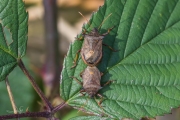
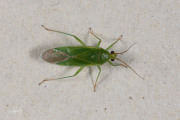
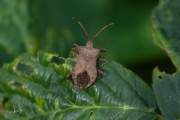
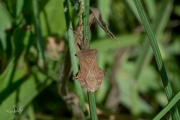
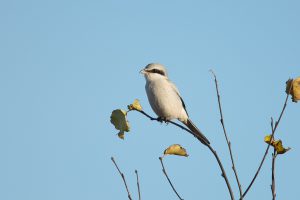
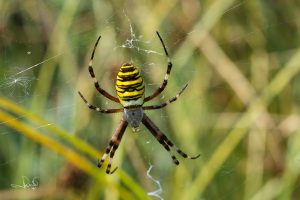
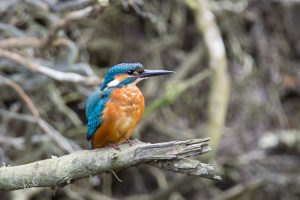
Hallo Theo, is er enig gevaar dat de iepenridderwants schade kan toebrengen aan jonge iepen? Twee jaar geleden ontdekte ik een ‘vreemdbladig stammetje’ in onze tuin. Digitale Plant Net en mijn Buurman bevestigde dat er een iepje was gaan groeien achter onze kapschuur. Vorige winter verplaatste ik dit jonge boompje naar ons weiland. Ik weet dat het gevreesde iepziekte van de jaren 70-80 werd veroorzaakt door een insect. Is de iepenridderwants ook zo gevaarlijk als dat beestje? Is er iets dat ik kan doen om mijn iepje te beschermen zo dat er ooit een ‘mighty elm’ hier kan groeien? Vriendelijke groet, Lindy
Hoi Lindy, de iepenziekte wordt veroorzaakt door twee schimmels (Ophiostoma ulmi en O. novo-ulmi). De verspreiding van de schimmels vindt onder meer plaats door twee kevertjes, de grote iepenspintkever (Scolytus scolytus) en de kleine iepenspintkever (S. multistriatus). Leuk weetje is dat de ziekte in het buitenland “Dutch Elm Disease” wordt genoemd, omdat een paar Nederlandse biologen deze begin 20e eeuw voor het eerst volledig beschreven hebben. Maar de iepenridderwants heeft hier dus niks mee te maken. Je hoeft niet te vrezen voor je iepje 😉
Prachtig werk Theo.
Morgen ga ik rustig de tijd nemen om wat dieper in je site te duiken.
Alvast veel succes gewenst.
Dank je Rudi!